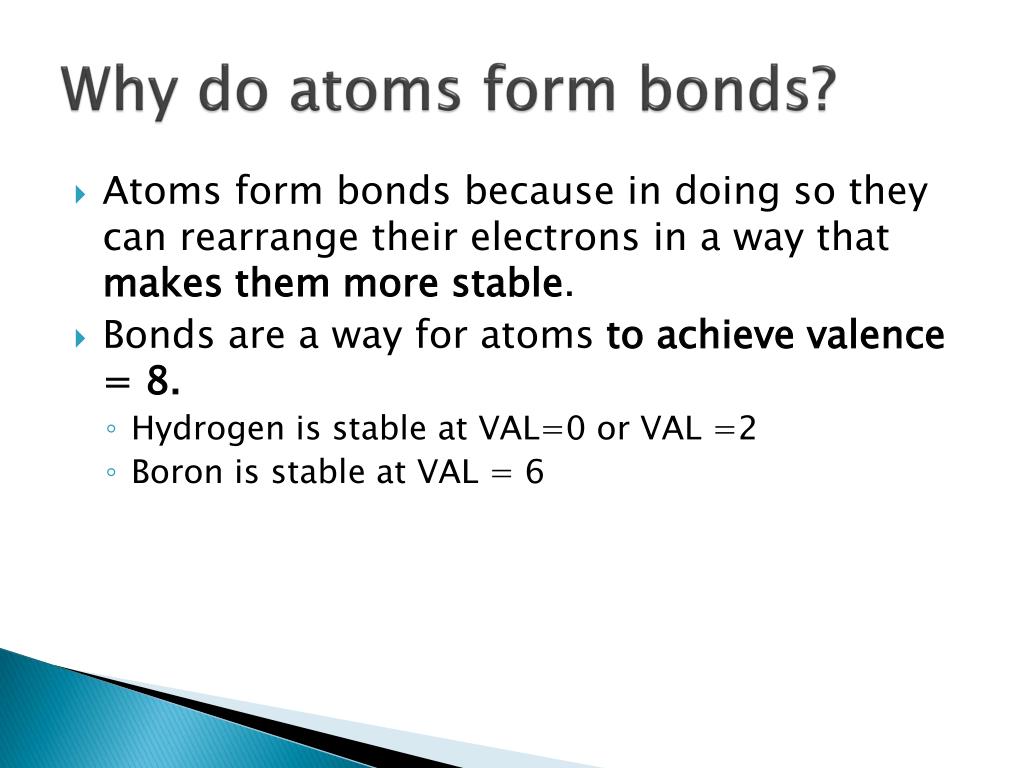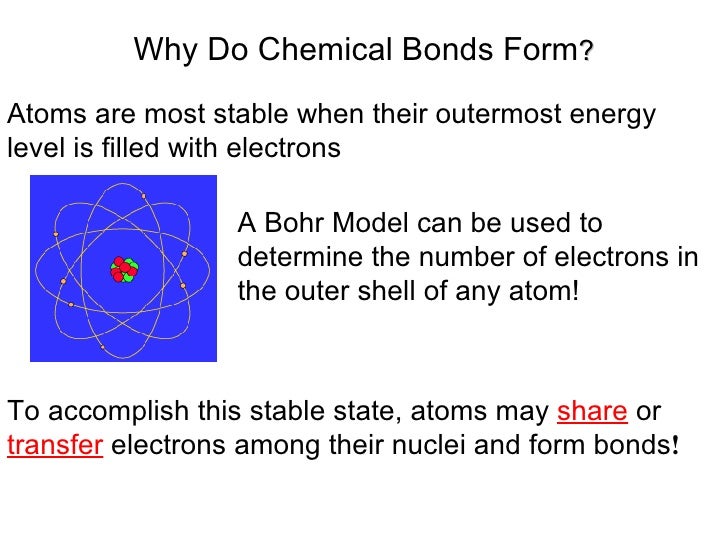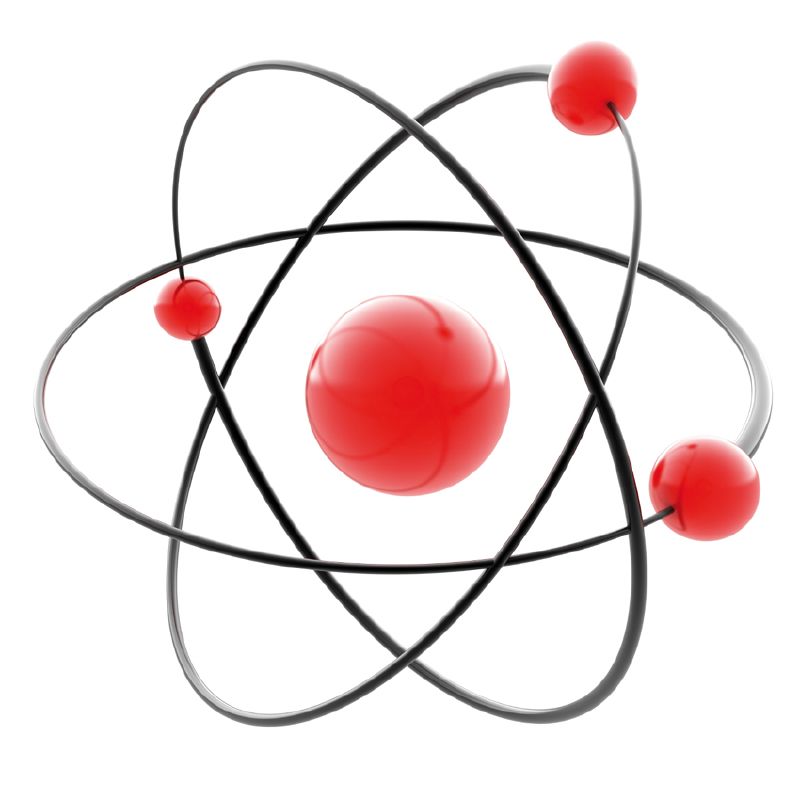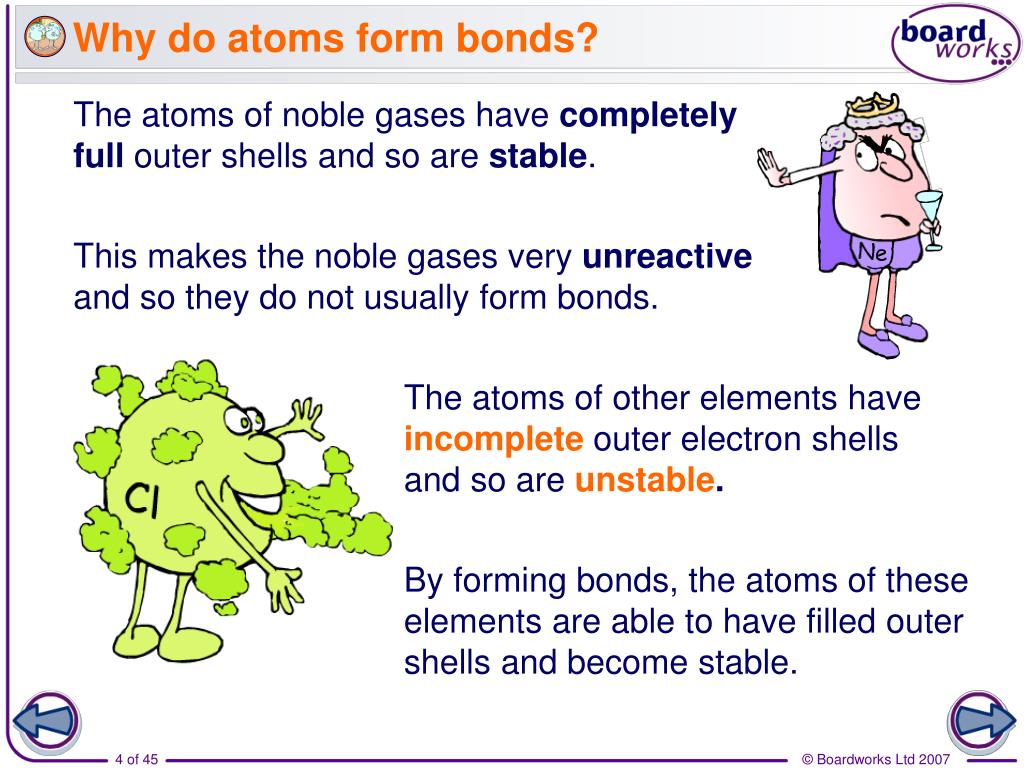Why Do Atoms Form Bonds With Other Atoms
Why Do Atoms Form Bonds With Other Atoms - This outermost shell is known as. Atoms form two basic bonds, covalent or ionic bonds, to fill the full outer shell of electrons. To achieve a stable electron arrangement atoms can lose, gain or share electrons. Web a double bond is formed when two atoms use two electron pairs to form two covalent bonds; A triple bond results when two atoms share three electron pairs to form three. There are several types of bond. Web if you learned in chemistry that some atoms tend to gain or lose electrons or form bonds with each other, those facts remain true even when the atoms or molecules are part of a. The combination of multiple atoms, or chemical bonding, forms molecules. An ionic bond is formed when one. Web main types of chemical bonds.
Web a double bond is formed when two atoms use two electron pairs to form two covalent bonds; Web the atoms of molecules are linked together through a reaction known as chemical bonding. Web atoms have to be close together to form a bond. The combination of multiple atoms, or chemical bonding, forms molecules. Web when atoms form bonds, they can achieve a stable electron arrangement. Web if you learned in chemistry that some atoms tend to gain or lose electrons or form bonds with each other, those facts remain true even when the atoms or molecules are part of a. A pure substance made from only one type of atom is called an element. The two main types of bonds formed between atoms are ionic bonds and covalent bonds. Elements are listed on the periodic table. Web main types of chemical bonds.
Web a double bond is formed when two atoms use two electron pairs to form two covalent bonds; Web atoms have to be close together to form a bond. Atomic structure of carbon atom showing the particles of an atom: Web when atoms form bonds, they can achieve a stable electron arrangement. The bond may result from the electrostatic. The two main types of bonds formed between atoms are ionic bonds and covalent bonds. Web the number of electrons in the outermost shell of a particular atom determines its reactivity, or tendency to form chemical bonds with other atoms. Web a chemical bond is a lasting attraction between atoms or ions that enables the formation of molecules, crystals, and other structures. Elements are listed on the periodic table. Web atoms can form strong bonds with each other, making molecules.
PPT Chemical Bonding What and Why PowerPoint Presentation, free
The bond may result from the electrostatic. Web the number of electrons in the outermost shell of a particular atom determines its reactivity, or tendency to form chemical bonds with other atoms. An ionic bond is formed when one. Web main types of chemical bonds. Elements are listed on the periodic table.
Why do atoms form bonds? Video] O Level Secondary Chemistry
There are several types of bond. Web when atoms form bonds, they can achieve a stable electron arrangement. Web a double bond is formed when two atoms use two electron pairs to form two covalent bonds; Web atoms have to be close together to form a bond. The bond may result from the electrostatic.
Biochemistry Honors
A triple bond results when two atoms share three electron pairs to form three. Web to achieve a full valence electrons shell. Web the atoms of molecules are linked together through a reaction known as chemical bonding. Atoms form two basic bonds, covalent or ionic bonds, to fill the full outer shell of electrons. Elements are listed on the periodic.
Why do atoms have electrons? How It Works Magazine
The two main types of bonds formed between atoms are ionic bonds and covalent bonds. This outermost shell is known as. Web main types of chemical bonds. Web if you learned in chemistry that some atoms tend to gain or lose electrons or form bonds with each other, those facts remain true even when the atoms or molecules are part.
Why Do Atoms Form Chemical Bond in Urdu Hindi Lecture /Chemistry for
This outermost shell is known as. In fact, they have to collide (bump together). The bond may result from the electrostatic. Elements are listed on the periodic table. Web a chemical bond is a lasting attraction between atoms or ions that enables the formation of molecules, crystals, and other structures.
PPT What are bonds? PowerPoint Presentation, free download ID5980343
Web main types of chemical bonds. Web a chemical bond is a lasting attraction between atoms or ions that enables the formation of molecules, crystals, and other structures. Web a double bond is formed when two atoms use two electron pairs to form two covalent bonds; To achieve a stable electron arrangement atoms can lose, gain or share electrons. A.
thinkbiggerdesigns Why Do Atoms Ions
There are several types of bond. The two main types of bonds formed between atoms are ionic bonds and covalent bonds. Web main types of chemical bonds. Web atoms can form strong bonds with each other, making molecules. The more “crowded” a given space is with atoms, the more likely it is that.
PPT Ions PowerPoint Presentation, free download ID6738771
The bond may result from the electrostatic. Web if you learned in chemistry that some atoms tend to gain or lose electrons or form bonds with each other, those facts remain true even when the atoms or molecules are part of a. Web atoms are individual units made up of protons, neutrons, and electrons. Web main types of chemical bonds..
why do atoms form bonds with other atoms
Web a chemical bond is a lasting attraction between atoms or ions that enables the formation of molecules, crystals, and other structures. Web atoms can form strong bonds with each other, making molecules. Atoms form two basic bonds, covalent or ionic bonds, to fill the full outer shell of electrons. Web atoms are individual units made up of protons, neutrons,.
PPT Chemical Bonding PowerPoint Presentation, free download ID5674609
Web a double bond is formed when two atoms use two electron pairs to form two covalent bonds; Web to achieve a full valence electrons shell. Web if you learned in chemistry that some atoms tend to gain or lose electrons or form bonds with each other, those facts remain true even when the atoms or molecules are part of.
A Triple Bond Results When Two Atoms Share Three Electron Pairs To Form Three.
The more “crowded” a given space is with atoms, the more likely it is that. This outermost shell is known as. The bond may result from the electrostatic. There are several types of bond.
Atoms Form Two Basic Bonds, Covalent Or Ionic Bonds, To Fill The Full Outer Shell Of Electrons.
An ionic bond is formed when one. Web the atoms of molecules are linked together through a reaction known as chemical bonding. Web a chemical bond is a lasting attraction between atoms or ions that enables the formation of molecules, crystals, and other structures. To achieve a stable electron arrangement atoms can lose, gain or share electrons.
Web Main Types Of Chemical Bonds.
Web if you learned in chemistry that some atoms tend to gain or lose electrons or form bonds with each other, those facts remain true even when the atoms or molecules are part of a. Web atoms are individual units made up of protons, neutrons, and electrons. A pure substance made from only one type of atom is called an element. Web when atoms form bonds, they can achieve a stable electron arrangement.
Web The Number Of Electrons In The Outermost Shell Of A Particular Atom Determines Its Reactivity, Or Tendency To Form Chemical Bonds With Other Atoms.
The combination of multiple atoms, or chemical bonding, forms molecules. Atomic structure of carbon atom showing the particles of an atom: In fact, they have to collide (bump together). Elements are listed on the periodic table.

![Why do atoms form bonds? Video] O Level Secondary Chemistry](https://icandochemistry942105908.files.wordpress.com/2021/06/thumb-1.png?w=1200)







